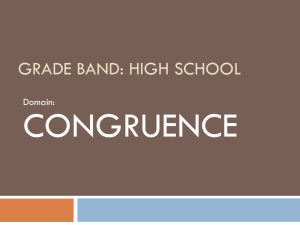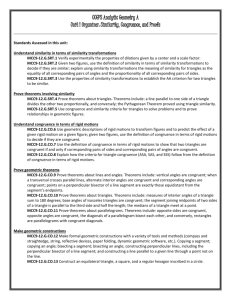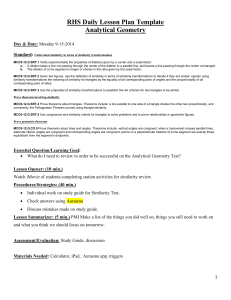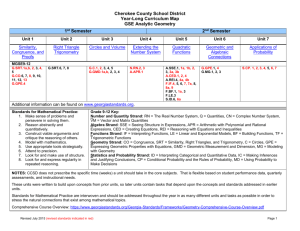G - Ingham Intermediate School District
advertisement
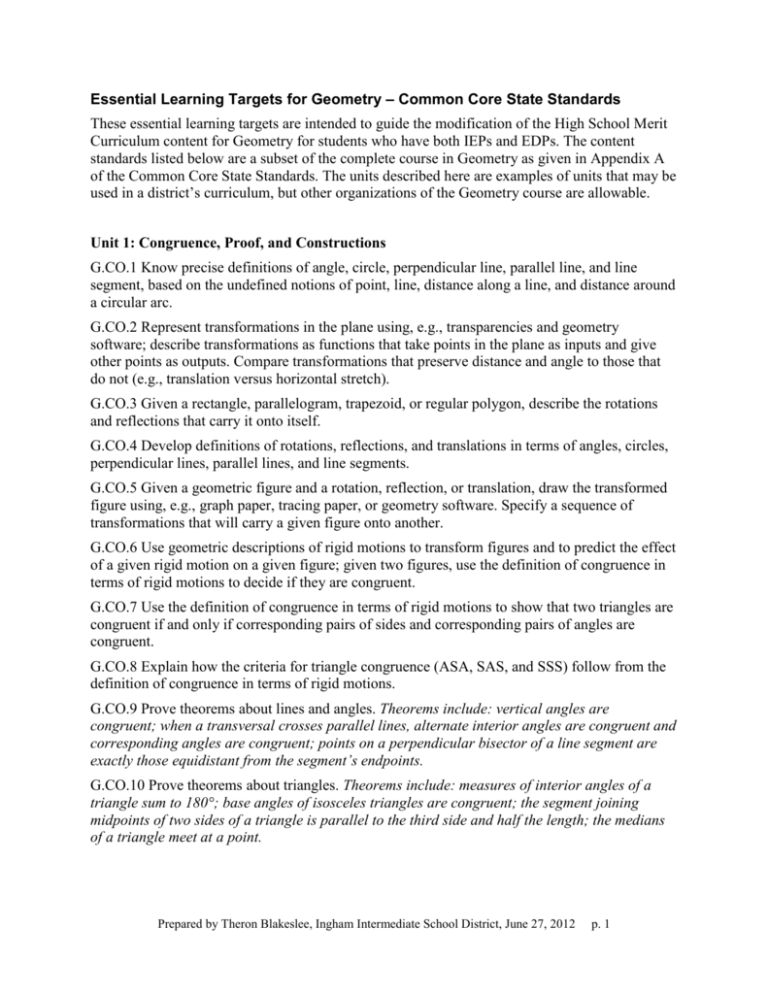
Essential Learning Targets for Geometry – Common Core State Standards These essential learning targets are intended to guide the modification of the High School Merit Curriculum content for Geometry for students who have both IEPs and EDPs. The content standards listed below are a subset of the complete course in Geometry as given in Appendix A of the Common Core State Standards. The units described here are examples of units that may be used in a district’s curriculum, but other organizations of the Geometry course are allowable. Unit 1: Congruence, Proof, and Constructions G.CO.1 Know precise definitions of angle, circle, perpendicular line, parallel line, and line segment, based on the undefined notions of point, line, distance along a line, and distance around a circular arc. G.CO.2 Represent transformations in the plane using, e.g., transparencies and geometry software; describe transformations as functions that take points in the plane as inputs and give other points as outputs. Compare transformations that preserve distance and angle to those that do not (e.g., translation versus horizontal stretch). G.CO.3 Given a rectangle, parallelogram, trapezoid, or regular polygon, describe the rotations and reflections that carry it onto itself. G.CO.4 Develop definitions of rotations, reflections, and translations in terms of angles, circles, perpendicular lines, parallel lines, and line segments. G.CO.5 Given a geometric figure and a rotation, reflection, or translation, draw the transformed figure using, e.g., graph paper, tracing paper, or geometry software. Specify a sequence of transformations that will carry a given figure onto another. G.CO.6 Use geometric descriptions of rigid motions to transform figures and to predict the effect of a given rigid motion on a given figure; given two figures, use the definition of congruence in terms of rigid motions to decide if they are congruent. G.CO.7 Use the definition of congruence in terms of rigid motions to show that two triangles are congruent if and only if corresponding pairs of sides and corresponding pairs of angles are congruent. G.CO.8 Explain how the criteria for triangle congruence (ASA, SAS, and SSS) follow from the definition of congruence in terms of rigid motions. G.CO.9 Prove theorems about lines and angles. Theorems include: vertical angles are congruent; when a transversal crosses parallel lines, alternate interior angles are congruent and corresponding angles are congruent; points on a perpendicular bisector of a line segment are exactly those equidistant from the segment’s endpoints. G.CO.10 Prove theorems about triangles. Theorems include: measures of interior angles of a triangle sum to 180°; base angles of isosceles triangles are congruent; the segment joining midpoints of two sides of a triangle is parallel to the third side and half the length; the medians of a triangle meet at a point. Prepared by Theron Blakeslee, Ingham Intermediate School District, June 27, 2012 p. 1 G.CO.11 Prove theorems about parallelograms. Theorems include: opposite sides are congruent, opposite angles are congruent, the diagonals of a parallelogram bisect each other, and conversely, rectangles are parallelograms with congruent diagonals. G.CO.12 Make formal geometric constructions with a variety of tools and methods (compass and straightedge, string, reflective devices, paper folding, dynamic geometric software, etc.). Copying a segment; copying an angle; bisecting a segment; bisecting an angle; constructing perpendicular lines, including the perpendicular bisector of a line segment; and constructing a line parallel to a given line through a point not on the line. Unit 2: Similarity, Proof, and Trigonometry G.SRT.1 Verify experimentally the properties of dilations given by a center and a scale factor. a) A dilation takes a line not passing through the center of the dilation to a parallel line, and leaves a line passing through the center unchanged. b) The dilation of a line segment is longer or shorter in the ratio given by the scale factor. G.SRT.2 Given two figures, use the definition of similarity in terms of similarity transformations to decide if they are similar; explain using similarity transformations the meaning of similarity for triangles as the equality of all corresponding pairs of angles and the proportionality of all corresponding pairs of sides. G.SRT.3 Use the properties of similarity transformations to establish the AA criterion for two triangles to be similar. G.SRT.5 Use congruence and similarity criteria for triangles to solve problems and to prove relationships in geometric figures. Unit 3: Extending to Three Dimensions G.GMD.3 Use volume formulas for cylinders, pyramids, cones, and spheres to solve problems. G.GMD.4 Identify the shapes of two-dimensional cross-sections of three-dimensional objects, and identify three-dimensional objects generated by rotations of two-dimensional objects. G.MG.1 Use geometric shapes, their measures, and their properties to describe objects (e.g., modeling a tree trunk or a human torso as a cylinder). Unit 4: Connecting Algebra and Geometry Through Coordinates G.GPE.7 Use coordinates to compute perimeters of polygons and areas of triangles and rectangles, e.g., using the distance formula. Unit 5: Circles With and Without Coordinates G.C.1 Prove that all circles are similar. G.C.2 Identify and describe relationships among inscribed angles, radii, and chords. Include the relationship between central, inscribed, and circumscribed angles; inscribed angles on a Prepared by Theron Blakeslee, Ingham Intermediate School District, June 27, 2012 p. 2 diameter are right angles; the radius of a circle is perpendicular to the tangent where the radius intersects the circle. Mathematical Practices (to be embedded in all content) 1) Make sense of problems and persevere in solving them. 2) Conjecture and justify using appropriate reasoning. 3) Engage and participate in mathematical conversations in whole class and small group settings. Make an argument using mathematics as a justification; consider and evaluate mathematical arguments of others. 4) Model real-world situations using visual representations and coordinate notation as appropriate. 5) Use appropriate tools strategically. 6) Attend to precision. Prepared by Theron Blakeslee, Ingham Intermediate School District, June 27, 2012 p. 3







